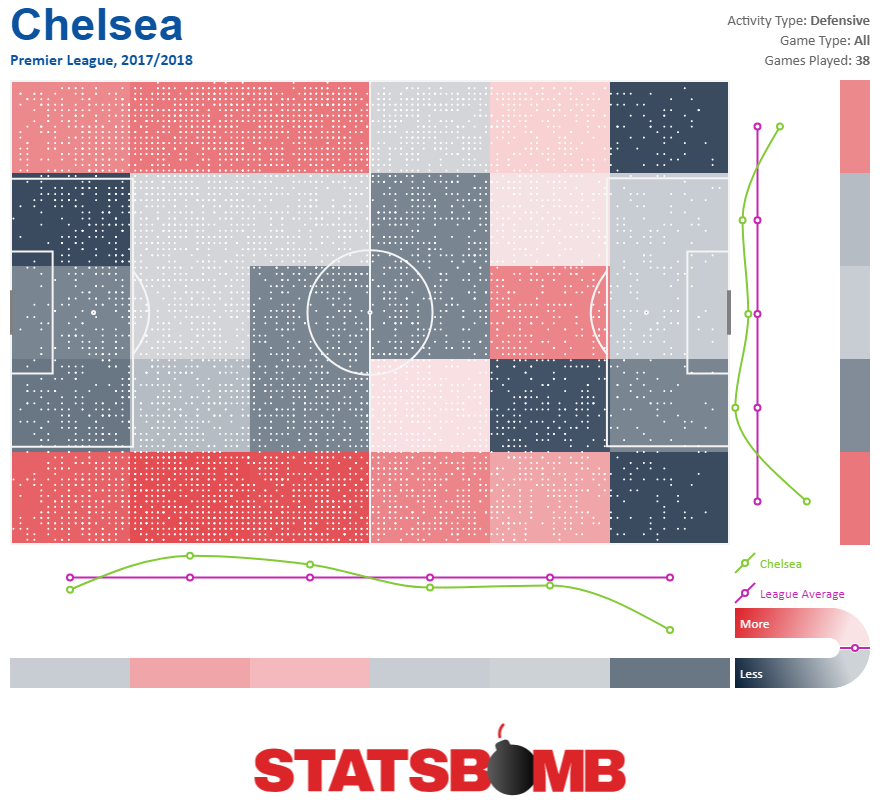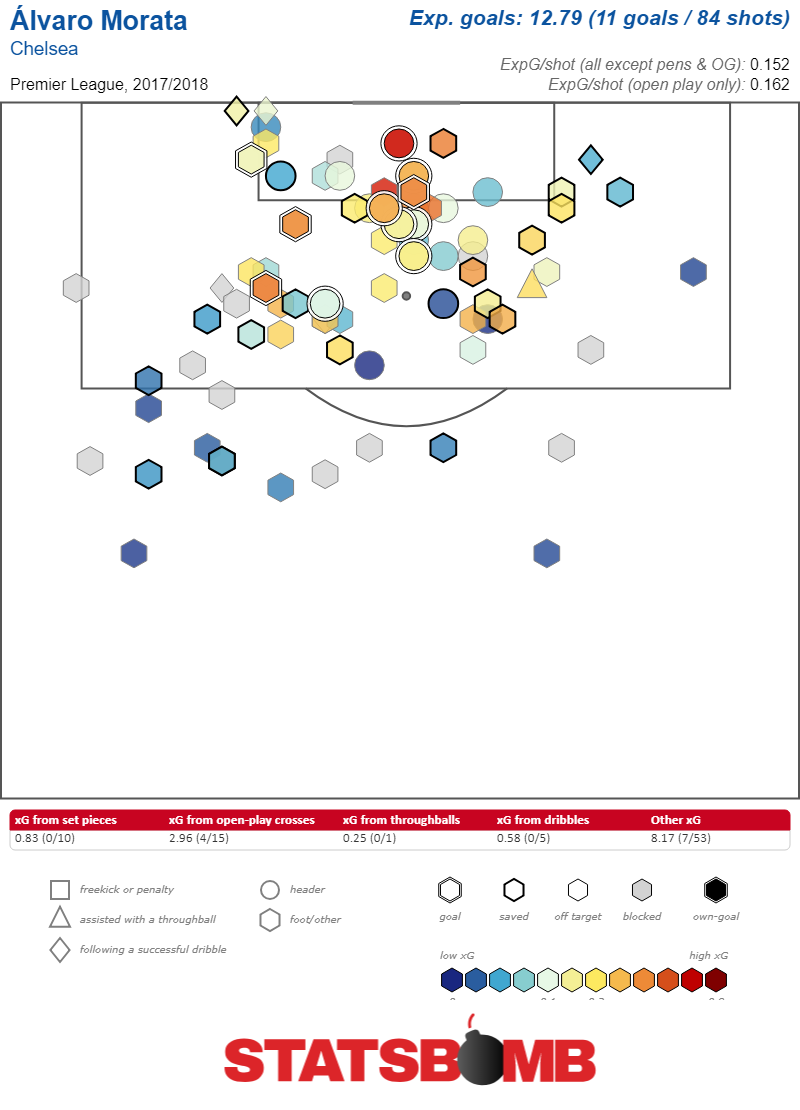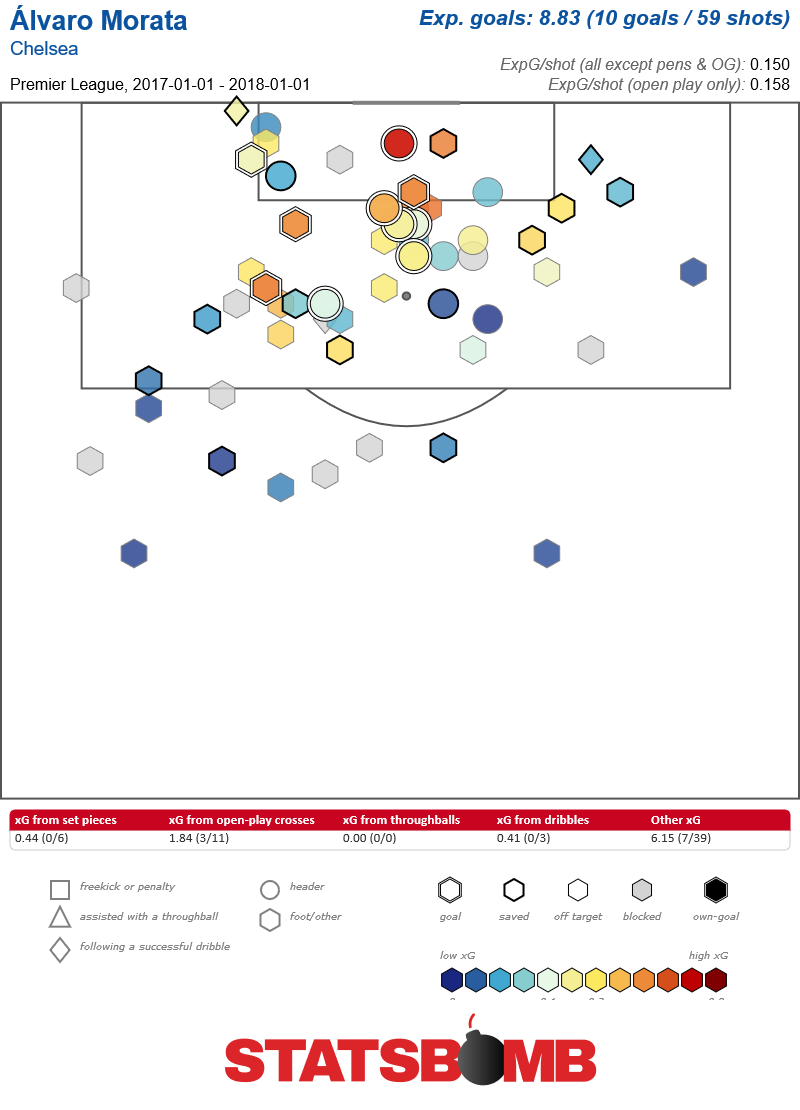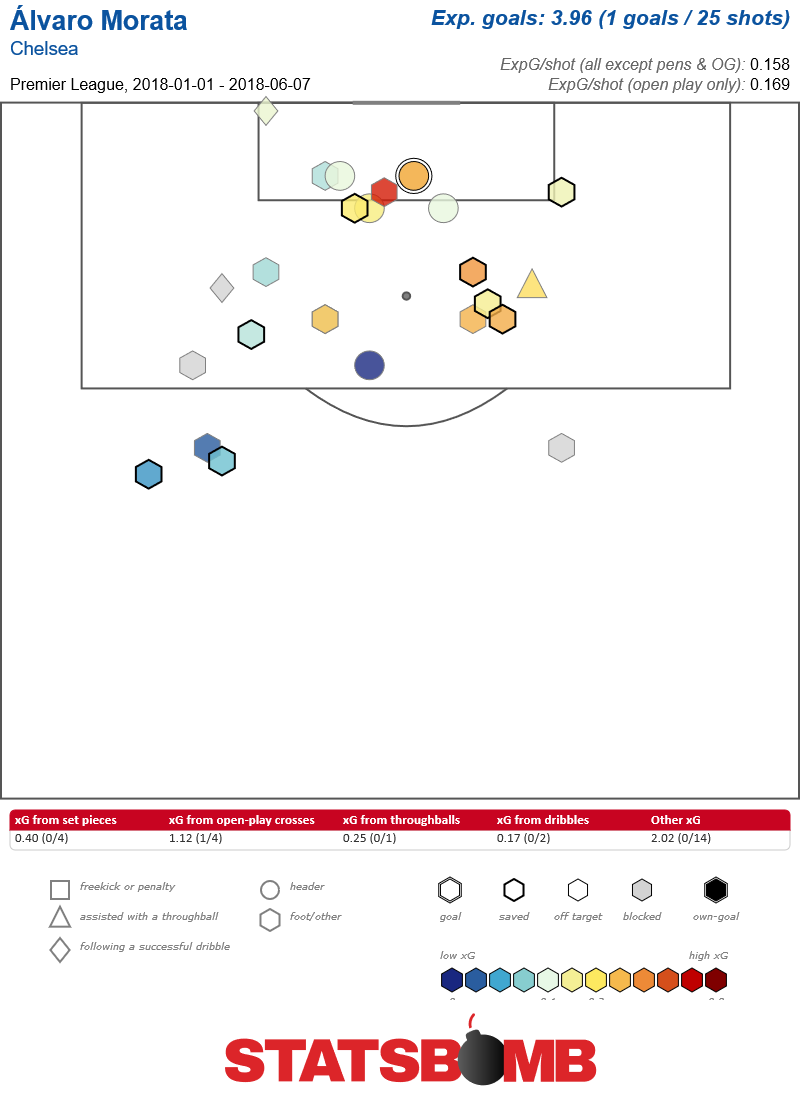Chelsea are a challenge to the premise of data driven previews. One major idea of analytics is that change is relatively rare. Filter out enough noise, control for the right factors, understand the way things work, and the past will be the best guide to the future. Then there’s Chelsea. Nothing causes whiplash quite like Chelsea. In the past four seasons they’ve won the league twice and finished fifth and tenth. They’re on their third manager in four years (fourth if you include Guus Hiddink’s caretaker stint). And to top it all off they’re going from a committed defensive manager in Antonio Conte, to an attacking maestro in Maurizio Sarri. Figuring out how exactly Chelsea’s recent past informs their immediate future is a complex task to undertake.
The Departed Defense
For two years Conte’s success was built on defense. He constructed a Chelsea side the zagged defensively while everybody else was busy zigging themselves into a high pressing aggressive tizzy. Last season Chelsea conceded 38 goals, tied for fourth with Liverpool. They were also fourth in expected goals conceded with 0.99 per game. But while the teams that pup better defensive numbers focused on winning the ball high up the field, Chelsea were ruthlessly effective at maintaining their shape, shepherding the ball to the sides and then pouncing.  All that red on the flanks in their own half of the field, that’s the team’s collective eyes lighting up as they corral opponents and take the ball back. A dedicated back three, protected by N’Golo Kante is impossible to break down, so teams eventually stop trying and filter it wide. Then either Chelsea would pounce or force a hopeful cross, which is a pretty effective strategy when Thibaut Courtois is standing there like a Redwood in goal to come collect. All of that is gone now. Courtois is going to be doing is great big giant ball gathering act in Madrid. Conte’s conservative, positionally based back three is a distant memory as Sarri implements an aggressive back four playing a high offside trap designed to squeeze opponents and facilitate winning the ball back quickly. There are positives and negatives to the change. Most of the positives will be seen on the attacking side of the ball, which we’ll get to in a second. But, there’s real reason for defensive, if not concern, at least trepidation. Cesar Aziplicueta was a revelation as an outside center back. He contributed mightily to the attack while leaving no space defensively, and somehow managed to never allow his height to be exploited. He will be fine as a rightback, but being fine is a far cry from being a quiet star. Chelsea seemingly have infinite center backs to occupy the two roles, from the still there Gary Cahill, to the still apparently still exists David Luiz, to talented but still with questions to answer Antonio Rudiger and Andreas Christiansen. It was easy for lots of those players to look good under Conte. His system protected them and allowed them to protect each other. Under Sarri they’re going to be exposed. They’re going to have to make plays. They’re also going to hope that Emerson is ready to be a consistent starter on a big time club, or that Marcos Alonso who excelled as a wingback is able to play as a top level fullback for the first time in his career. It’s not that these things can’t happen, it’s that it’s not a foregone conclusion that they will. Shifting a squad that had excelled defensively in a conservative back three and was crafted to be deployed that way into a wide open back two comes with substantial risks.
All that red on the flanks in their own half of the field, that’s the team’s collective eyes lighting up as they corral opponents and take the ball back. A dedicated back three, protected by N’Golo Kante is impossible to break down, so teams eventually stop trying and filter it wide. Then either Chelsea would pounce or force a hopeful cross, which is a pretty effective strategy when Thibaut Courtois is standing there like a Redwood in goal to come collect. All of that is gone now. Courtois is going to be doing is great big giant ball gathering act in Madrid. Conte’s conservative, positionally based back three is a distant memory as Sarri implements an aggressive back four playing a high offside trap designed to squeeze opponents and facilitate winning the ball back quickly. There are positives and negatives to the change. Most of the positives will be seen on the attacking side of the ball, which we’ll get to in a second. But, there’s real reason for defensive, if not concern, at least trepidation. Cesar Aziplicueta was a revelation as an outside center back. He contributed mightily to the attack while leaving no space defensively, and somehow managed to never allow his height to be exploited. He will be fine as a rightback, but being fine is a far cry from being a quiet star. Chelsea seemingly have infinite center backs to occupy the two roles, from the still there Gary Cahill, to the still apparently still exists David Luiz, to talented but still with questions to answer Antonio Rudiger and Andreas Christiansen. It was easy for lots of those players to look good under Conte. His system protected them and allowed them to protect each other. Under Sarri they’re going to be exposed. They’re going to have to make plays. They’re also going to hope that Emerson is ready to be a consistent starter on a big time club, or that Marcos Alonso who excelled as a wingback is able to play as a top level fullback for the first time in his career. It’s not that these things can’t happen, it’s that it’s not a foregone conclusion that they will. Shifting a squad that had excelled defensively in a conservative back three and was crafted to be deployed that way into a wide open back two comes with substantial risks.
Jumpstarting the Attack
The rewards for that risk come in the form of actually scoring goals. Conte’s defensive side relied on precision in attack, creating relatively fewer opportunities than the other top Premier League sides. They only created 1.59 expected goals per match, significantly behind all of the other big six. Largely that was because with such a dedicate defense Chelsea were often times dedicating only a striker and Eden Hazard to break quickly at defenses. It’s hard to create great chances that way. Striker Alvaro Morata, who was brought in last season to replace Diego Costa as the tip of Chelsea’s attack had a disappointing season. And, while 11 goals is slightly disappointing, his xG totals were closer to 13, and he had a very respectable 0.15 expected goals per shot. On average when he shot it was from pretty effective positions.  His xG per 90 of 0.53 was fifth among all players that played over 1200 minutes, which might seem comical given how he walked out of last season with a reputation for missing the net a lot. But his scoring record was actually quite respectable. Those 11 goals came in only a little over 2100 minutes, giving him a goal scoring rate of 0.45 was ninth among players with over 1200 minutes. On a minute for minute basis Morata’s scoring was fine if slightly disappointing, but he created shots opportunities for himself at a rate more than adequate for a striker at a top team. The problem with Morata is that all of his success was frontloaded. He scored his goals early…
His xG per 90 of 0.53 was fifth among all players that played over 1200 minutes, which might seem comical given how he walked out of last season with a reputation for missing the net a lot. But his scoring record was actually quite respectable. Those 11 goals came in only a little over 2100 minutes, giving him a goal scoring rate of 0.45 was ninth among players with over 1200 minutes. On a minute for minute basis Morata’s scoring was fine if slightly disappointing, but he created shots opportunities for himself at a rate more than adequate for a striker at a top team. The problem with Morata is that all of his success was frontloaded. He scored his goals early…  Then limped to the finish line.
Then limped to the finish line.  A healthy and productive Morata will likely be better next year than last, and should be able to thrive in a Sarri side that’s interested in using the midfield to play through opponents. And what a midfield it is. Chelsea added Jorginho from Sarri’s old club Napoli and Mateo Kovacic on loan from Real Madrid. They’ll partner with N’Golo Kante, the best defensive player in the world, to contend for being one of the strongest midfield units in the game. Napoli is extremely committed to moving the ball into the final third and using possession to attack their opponents. They had by far the most deep completions of any team in Serie A last season. They are reluctant crossers of the ball, and use lots of midfield movement and interchanging to pry open spaces from their base 4-3-3 system. Adding Kovacic and Jorginho means that all three of Chelsea’s midfielders (assuming that’s the starting unit) will be able to cover loads of ground. Kante’s presence means his two partners will have to worry less about getting caught up field, and both will be able to attack the penalty box when the situation calls for it. Courtois’ replacement in goal is also, in an odd way, motivated by Sarri’s attacking style. Kepa Arrizabalaga arrives from Athletic Bilbao with a reputation for being good with the ball at his feet, and an excellent shot stopper. Those are the kinds of skills necessary in a system designed to play on the front foot. While Courtois was perfectly suited for commanding a crowded area, shutting down crosses and making himself big in front of goal when necessary, Kepa’s remit will be different. He’ll have much more space to command, much more passing to pull off, and in general he’ll likely face a difference profile of shot.
A healthy and productive Morata will likely be better next year than last, and should be able to thrive in a Sarri side that’s interested in using the midfield to play through opponents. And what a midfield it is. Chelsea added Jorginho from Sarri’s old club Napoli and Mateo Kovacic on loan from Real Madrid. They’ll partner with N’Golo Kante, the best defensive player in the world, to contend for being one of the strongest midfield units in the game. Napoli is extremely committed to moving the ball into the final third and using possession to attack their opponents. They had by far the most deep completions of any team in Serie A last season. They are reluctant crossers of the ball, and use lots of midfield movement and interchanging to pry open spaces from their base 4-3-3 system. Adding Kovacic and Jorginho means that all three of Chelsea’s midfielders (assuming that’s the starting unit) will be able to cover loads of ground. Kante’s presence means his two partners will have to worry less about getting caught up field, and both will be able to attack the penalty box when the situation calls for it. Courtois’ replacement in goal is also, in an odd way, motivated by Sarri’s attacking style. Kepa Arrizabalaga arrives from Athletic Bilbao with a reputation for being good with the ball at his feet, and an excellent shot stopper. Those are the kinds of skills necessary in a system designed to play on the front foot. While Courtois was perfectly suited for commanding a crowded area, shutting down crosses and making himself big in front of goal when necessary, Kepa’s remit will be different. He’ll have much more space to command, much more passing to pull off, and in general he’ll likely face a difference profile of shot.
Different or Better?
It’s quite easy to predict that Chelsea will be different. Different manager, different formation, different style, different different, different. It’s harder to predict whether that will make them better. The default is to assume that teams always eventually rise and fall to their talent level, and that generally speaking their talent level is determined by their finances. That methodology while dependable is more of a sledgehammer than a scalpel. That would put Chelsea roughly third. That’s reasonable, and it’s a reasonable estimation of where they’ve been over the last half decade or more. It’s also not particularly helpful when it comes to figuring out where they’ll finish this particular season. The midfield is better, the defense is probably worse, not through any fault of it’s own, but because the club molded itself to a back three under Conte’s short time in charge, and an adjustment back will take time and some personnel changes. The attack despite an unending string of transfer rumors to the contrary is the same. Does that all add up to a team that can challenge Manchester City? Probably not, but it’s not impossible if things break absolutely perfectly and Sarri-ball takes the Premier League by storm. City’s mostly unassailable perch atop the league though is more about the defending champions than Chelsea. Chelsea can, and should, compete for a top four spot, however. They were in the thick of that hunt for most of last season, after all. A little improvement thanks to the upgraded midfield, a step back from Spurs and Manchester United and Chelsea will be right back in the hunt. There’s also at least some chance that Sarri’s success in Italy doesn’t translate. Possession based football is hard. In his first season Pep Guardiola struggled to adjust with Manchester City, finishing third in the process. The league possesses a depth and physicality that Serie A does not, and it’s both harder to keep the ball and harder to keep from being exposed on the counterattack. There’s a chance, albeit a small one that Sarri’s preferred method of play simply doesn’t end up working. So, in summary, Chelsea might be better, they might be the same, or they might be worse. This isn’t exactly illuminating from a preview, of course, but that’s the unique challenge of Chelsea. The changes make them different from last year. Their recent history suggests that there is a high degree of variability around their talent level. Sometimes the only answer really is to wait and see.